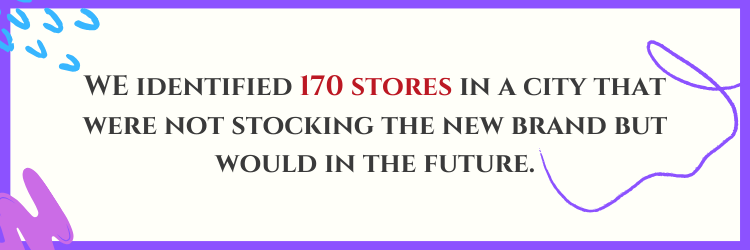10 Sep


Our client is an established Fast-Moving Consumer Goods (FMCG) company. A new entrant (let’s call it Brand X) had infiltrated the market and was taking up shelf space and eating into our client’s Market Share.

CHALLENGE
The best way for our FMCG client to stop this advance was to
Identify the shops that were vulnerable to the competition’s product, and put in preventive sales promotions at those stores to nullify the competitive advantage of Brand X.
However, all we had was the stocking & sales data for these stores. We needed to be able to identify these stores using just these inputs.
The end objectives was for the sales person to be able to look at the brands in a particular store and then based on just that information decide whether to put in the promotional program or not. Of course, the promo had a cost associated with it. Therefore, it would not be rolled out to all the stores, just the vulnerable ones.
SOLUTION
As a starting point, Numr Research focused on one city where the penetration of Brand X was high.
The first order of business was to narrow down the FMCG stores we needed to target. Therefore, we used K-Mode Clustering on brand availability data to generate 3 clusters. These 3 clusters explained 70% of the variance in the data.
This step allowed us to identify similar ‘groups of stores’ or ‘cluster’ based on the brands stocked. We used 20 brands and 4 store parameters to create the clusters. However, this technique created some overlap between the clusters. Although, the pattern was clear as to which type of FMCG stores belong to a cluster, the brand associations were not sufficiently distinguished.
Thus,
Our second step was to isolate the brands that have the biggest correspondence with each other.
Indeed, this is the information that sales representative will be able to see at stores. Therefore, we needed to figure out what to tell them so that they can quickly identify which cluster a store belongs to, by only looking at the brands. Hence, in order to highlight the brand associations, we decided to use the volume rather than the availability information to run a correspondence analysis. We did this to get a clearer picture of which brands are mostly associated with each cluster.
Now, not only did we know the kind of stores that were a problem.. Additionally, we also knew the brands that are most likely to be carried by these FMCG stores, that are most vulnerable to brand X.
Using this information we needed to identify the stores in a particular city that would start stocking Brand X.
PREDICTIVE ANALYTICS FOR FMCG
To begin this process, Numr Research looked at the stores that were currently stocking Brand X. Then, we looked at the historic data to identify an inflection point (or kink) where the conversion could have taken place. In short, these stores acted as the Training Data Set. Furthermore, this helped in predicting the weightage of the levers that would tip the currently virgin stores to start stocking Brand X.
Using this data and Predictive Analytics, Numr built a Predictive Model to identify the potentially vulnerable stores.
Interestingly, this model identified 170 stores in the city that were not stocking Brand X but would in the future.
RESULT
- Numr Research identified with 70% accuracy the stores that are vulnerable to Brand X in the future.
- Furthermore, Numr also created a simplified model for the ‘on the ground’ sales team. This model allowed a salesperson to merely look at the list of brands stocked and raise an alarm if the store was vulnerable. Since, this could be done based on only the pattern of stocked brands, it was fairly simple and effective.
| Thank you for Signing Up |




